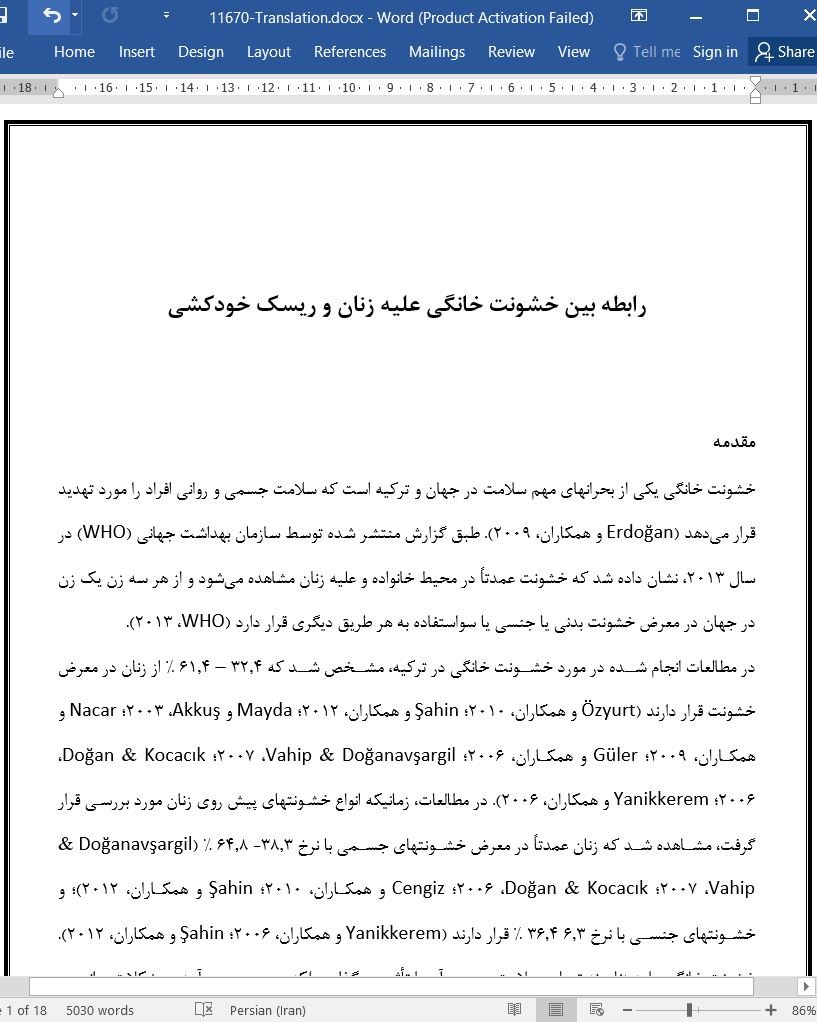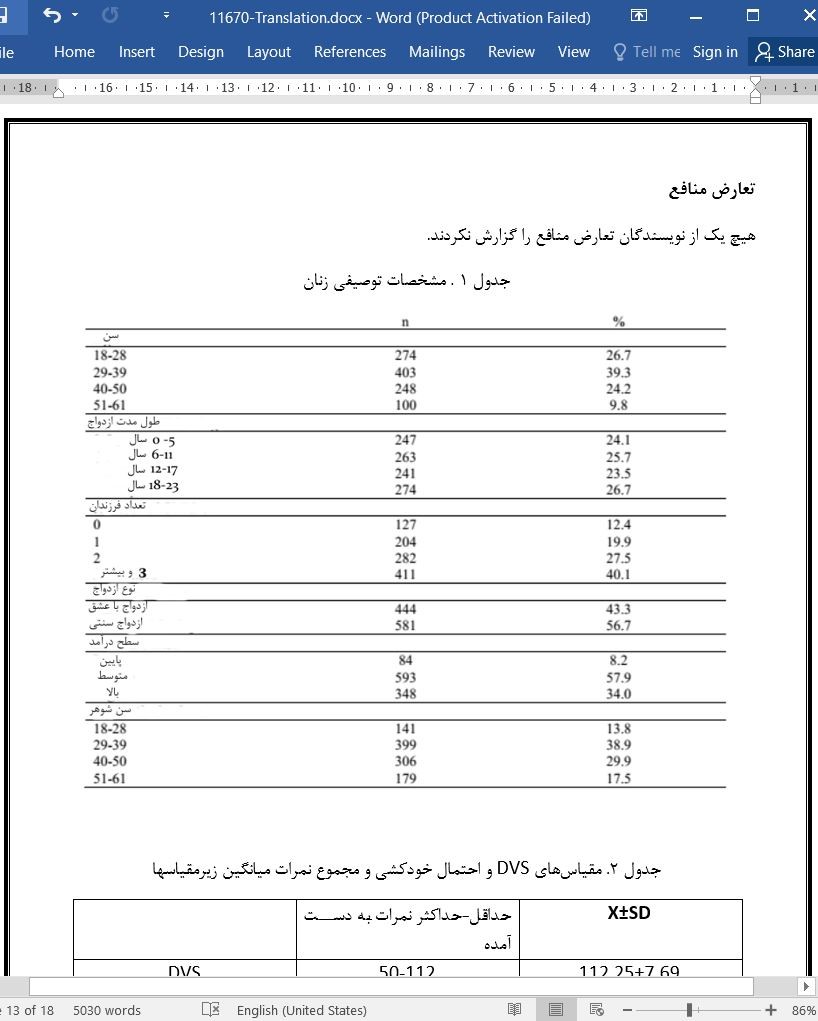
رابطه بین خشونت خانگی علیه زنان و ریسک خودکشی
مقدمه
خشونت خانگی یکی از بحرانهای مهم سلامت در جهان و ترکیه است که سلامت جسمی و روانی افراد را مورد تهدید قرار میدهد (Erdoğan و همکاران، 2009). طبق گزارش منتشر شده توسط سازمان بهداشت جهانی (WHO) در سال 2013، نشان داده شد که خشونت عمدتاً در محیط خانواده و علیه زنان مشاهده میشود و از هر سه زن یک زن در جهان در معرض خشونت بدنی یا جنسی یا سواستفاده به هر طریق دیگری قرار دارد (WHO، 2013).
در مطالعات انجام شده در مورد خشونت خانگی در ترکیه، مشخص شد که 32.4 – 61.4 % از زنان در معرض خشونت قرار دارند (Özyurt و همکاران، 2010؛ Şahin و همکاران، 2012؛ Mayda و Akkuş، 2003؛ Nacar و همکاران، 2009؛ Güler و همکاران، 2006؛ Doğanavşargil & Vahip، 2007؛ Kocacık & Doğan، 2006؛ Yanikkerem و همکاران، 2006). در مطالعات، زمانیکه انواع خشونتهای پیش روی زنان مورد بررسی قرار گرفت، مشاهده شد که زنان عمدتاً در معرض خشونتهای جسمی با نرخ 38.3- 64.8 % (Doğanavşargil & Vahip، 2007؛ Kocacık & Doğan، 2006؛ Cengiz و همکاران، 2010؛ Şahin و همکاران، 2012)؛ و خشونتهای جنسی با نرخ 6.3 36.4 % قرار دارند (Yanikkerem و همکاران، 2006؛ Şahin و همکاران، 2012). خشونت خانگی علیه زنان نه تنها بر سلامت جسمی آنها تأثیر میگذارد، بلکه موجب بوجود آمدن مشکلات روانی در آنها نیز میشود. مهمترین مشکلات روانی که، پس از خشونت خانگی در زنان دیده میشوند عبارتند از اختلال استرس پس از سانحه، اختلال اضطرابی، و افسردگی (Vahip & Doğanavşargil، 2006؛ Cengiz و همکاران، 2010). مشاهده شده است که زنان بطور کل پس از خشونت این وضعیت را پنهان میکنند، و منزوی و افسرده میشوند. زنان میتوانند به خودکشی به عنوان راه فراری برای خلاص شدن از این و ضعیت روانی فکر کنند. به این دلیل، میتوان فهمید که زنانی که در معرض خشونت خانگی قرار دارند، از نظر ارتکاب برای خودکشی در گروه پرخطر قرار میگیرند (Özyurt & Deveci، 2010؛ Şahin و همکاران، 2012؛ Temiz و همکاران، 2014؛ WHO، 2005).
Introduction
Domestic violence is one of major health crises in the world and in Turkey that threaten the physical and mental health (Erdoğan et al., 2009). According to a report published by the World Health Organization (WHO) in 2013, it is reported that the violence is mostly experienced at family environment and against women, one out of every three women in the world is exposed to physical or sexual violence or abused in another way (WHO, 2013).
In the studies conducted on domestic violence in Turkey, it has been determined that 32.4- 61.4% of women are exposed to violence (Özyurt et al., 2010; Şahin et al., 2012; Mayda & Akkuş, 2003; Nacar et al., 2009; Güler et al., 2006; Doğanavşargil & Vahip, 2007; Kocacık & Doğan, 2006; Yanikkerem et al., 2006). In the studies, when the types of violence to which women are exposed were examined, it was observed that the women were exposed mostly to physical violence with the rate of 38.3-64.8% (Doğanavşargil & Vahip, 2007; Kocacık & Doğan, 2006; Cengiz et al., 2010; Şahin et al., 2012); and sexual violence with the rate of 6.3-36.4% (Yanikkerem et al., 2006; Şahin et al., 2012). Domestic violence against women not only affects the physical health of women but also causes the psychological problems. The most important mental problems seen in women after domestic violence are post-traumatic stress disorder, anxiety disorder, and depression (Vahip & Doğanavşargil, 2006; Cengiz et al., 2010). It is seen that women generally hide this situation after the violence, withdraw into themselves, and fall into depression. Women can think of suicide as an escape to get rid of this psychological situation. For this reason, it is known that women exposed to domestic violence are in a higher risk group in terms of attempting to suicide (Özyurt & Deveci, 2010; Şahin et al., 2012; Temiz et al., 2014, WHO 2005).
مقدمه
موضوعات/روشها
مقیاس خشونت خانگی (DVS)
مقیاس احتمال خودکشی
جمع آوری دادهها
اصول اخلاقی مطالعه
ارزیابی دادههای مطالعه
نتایج
بحث
نتیجه گیری و ملاحظات
منابع
Introduction
Material / Methods
Domestic violence Scale (DVS)
Suicide Probability Scale
The ethical principles of the study
Assessment of the Study Data
Results
Discussion
REFERENCES
- اصل مقاله انگلیسی با فرمت ورد (word) با قابلیت ویرایش
- ترجمه فارسی مقاله با فرمت ورد (word) با قابلیت ویرایش، بدون آرم سایت ای ترجمه
- ترجمه فارسی مقاله با فرمت pdf، بدون آرم سایت ای ترجمه



